Quick Take: Timing Matters: States Waiting for a Supreme Court Decision to Plan an Exchange
State-based health insurance exchanges are an important component of the Patient Protection and Affordable Care Act (ACA) designed to extend subsidized private health insurance coverage to millions of Americans by 2014. Though projections show exchange enrollment could grow to 20 million individuals nationally, aggressive planning on the part of states will be necessary to meet implementation timelines—exchanges must be fully operational by January 1, 2014 and the Department of Health and Human Services will begin certifying exchange readiness by January 2013. Recognizing the urgency, many states initiated planning activities soon after the passage of the ACA, creating task forces or workgroups to study exchange design options. Many also applied for and were awarded federal Level 1 Exchange Establishment grants to fund planning activities, including the development of information technology (IT) systems. However, legal challenges to the ACA have created uncertainty for states and have led some to slow or halt exchange planning efforts in recent months. The implications of these decisions are significant. Delays in exchange planning mean fewer states will likely meet the timelines for implementing a state-based exchange and will instead be forced to default to a federal exchange or a federal-state partnership model.
To date, 12 states have halted exchange planning while awaiting a ruling from the Supreme Court on the constitutionality of the ACA, which is not expected until late June. Another five states indicate that while they will not pursue exchange legislation until the Supreme Court rules, they will continue planning for an exchange. Nationally, over half of states are proceeding with exchange planning- including all of the 14 states and the District of Columbia that have established exchanges either through legislation or executive order. The remaining six states never seriously began planning for an exchange and while they have not explicitly announced an intention to wait on the Supreme Court ruling, it may be a factor in their decisions.

Before announcing they would halt all or certain aspects of exchange planning, the 17 states waiting on a Supreme Court decision were in different phases of development. Several states, including Alaska, Florida, and Texas had undertaken minimal planning work prior to their announcement. These states were arguably not very different from those within the “no significant planning” category and it is likely not much additional ground was lost with an announcement to waitHowever, the majority of states that decided to wait for a Supreme Court decision were in fact making moderate exchange planning progress prior to their announcement. Many of these states had designated an entity responsible for coordinating exchange development or for studying the feasibility of establishing an exchange. In Alabama, Georgia, Maine, and Virginia, Commissions had already issued recommendations for how a state-based exchange should be designed. Seven states had been awarded federal Level 1 Exchange Establishment grants before announcing they would place their planning efforts on hold. Another state, South Dakota, had applied for an Establishment grant, though the grant had not been awarded prior to the Governor’s announcement. Kansas’ Insurance Department had organized extensive stakeholder workgroups comprised of hundreds of volunteers which met regularly developing exchange recommendations. Virginia had passed legislation expressing its intent to establish a state exchange and Indiana’s Governor signed an Executive Order conditionally establishing a nonprofit exchange. By waiting for a Supreme Court ruling, states that had been making moderate progress increased the likelihood that instead of having a state-based exchange, they will default to a federal exchange or a partnership model come 2014.
States Waiting on Ruling from the Supreme Court on the Constitutionality of the Affordable Care Act

What happens next will depend on how the Supreme Court rules. If it tosses out most or all of the law, states that decided to slow or stop exchange planning will not have expended additional resources on creating a new infrastructure they would not support in the absence of the federal law. If, however, the Supreme Court upholds most or all of the law, these states will be left with a considerably shortened timeframe for building their exchanges. By mid-November 2012, states are required to submit a blueprint (.pdf) for approval indicating whether they plan to run their own exchange or will participate in a federal-state partnership exchange.
States that delay implementation until the Supreme Court ruling will face significant challenges in meeting the November deadline for a state-based exchange. It will be difficult to build the IT systems and other components needed to support the exchange since much of the exchange infrastructure requires longer lead times for development. Also, many 2012 legislative sessions will have ended by the time the Court rules in June and states may not be able to enact authorizing exchange legislation. Exchange establishment legislation may be essential to receiving conditional federal approval for a state-based exchange. Without such approval, it is more likely the federal government will need to step in to run all or part of the exchanges in these states. By ceding responsibility for key aspects of their exchanges to the federal government, states forfeit the ability to tailor the exchange to meet the specific needs of their state.
